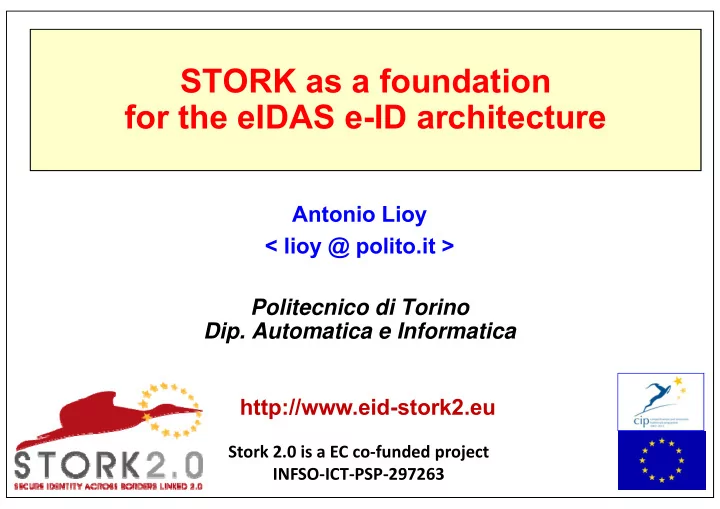

STORK as a foundation for the eIDAS e-ID architecture Antonio Lioy < lioy @ polito.it > Politecnico di Torino Dip. Automatica e Informatica http://www.eid-stork2.eu Stork 2.0 is a EC co ‐ funded project INFSO ‐ ICT ‐ PSP ‐ 297263
Stork (2008-2011) + Stork 2.0 (2012-2015) 21 countries 100+ e-IDs (and much more coming as part of e-SENS)
Pan-european eID e-identity = authentication + certified attributes set of certified European attributes lexicon (multilanguage attribute names) syntax (possible values) semantics (e.g. surname) various authentication credentials reusable password, one-time-password, cellphone, software certificate, smart-card used in a transparent way and with legal value (according to the citizen's country)
Adaptive security and privacy protection various authentication levels crypto strength of the authentication technique strength of the identification process QAA (Quality of Authentication Assurance) 1…4 requested (by the service) versus effective level (depending on the authentication technique used) privacy protection and localization user talks with her own country and provides explicit consent for the required attributes attributes managed end-to-end (no storage of personal data in the infrastructure) minimal disclosure (NEED-TO-KNOW principle)
The Stork infrastructure Swedish service Stork provider gateway Italian Stork gateway 2. go 3. select Stork! 1. ask for your country service 4a. consent? 4b. which e-ID? e-ID + attribute Italian provider 5a. authentication citizen (Italian) 5b. consent (final)
eIDAS e-ID interoperability framework (I) based on the Stork architecture more alignment with standards ISO LoA (Level of Assurance) use SAML native constructs where available (e.g. requested and actual LoA) operational security crypto-suites for secure channels (TLS) and SAML signature/encryption – minimum and suggested security management "certification" trusted distribution of gateway meta-data (signature and encryption certificates, node addresses, …) extended TSL or SAML meta-data
eIDAS e-ID interoperability framework (II) technical improvements encryption of assertions to avoid attacks in the browser gateway metadata include available attributes (to avoid asking for what is not available) sector-specific gateways transparent transport of sector-defined attributes
Food for thoughts usage of eIDAS by the private sector mix-and-match with other e-IDs (private or sector- specific) attributes, attributes and more attributes (and mandates, delagtion of powers, …)
Thank you for your attention! www.eid-stork2.eu
Recommend
More recommend